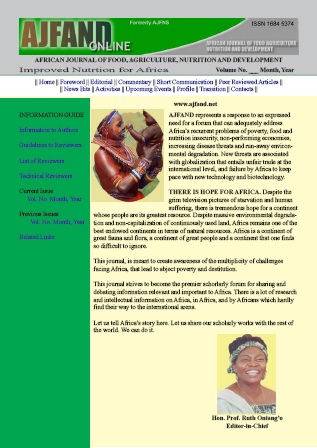
|
African Journal of Food, Agriculture, Nutrition and Development
Rural Outreach Program
ISSN: 1684-5358
EISSN: 1684-5358
Vol. 14, No. 2, 2014, pp. 8761-8775
|
 Bioline Code: nd14024
Bioline Code: nd14024
Full paper language: English
Document type: Research Article
Document available free of charge
|
|
|
African Journal of Food, Agriculture, Nutrition and Development, Vol. 14, No. 2, 2014, pp. 8761-8775
| en |
KNOWLEDGE, USE AND SENSORY EVALUATION OF RED PALM OIL OGI BY CAREGIVERS IN MAKURDI, NIGERIA
Adewuyi, O.A.; Abu, J.O.; Amuta, E.U.; Abu, G.A.; Iombor, T.T. & Ingbian, E.K.
Abstract
Vitamin A deficiency is one of the major public health challenges in many developing countries affecting mainly children under 5 years of age and contributes to severity of life-threatening infections such as diarrhoea and measles. Over the years, several effective strategies have been adopted to combat vitamin A deficiency with the attendant challenge of sustainability. Food-based approaches based on vitamin A-rich, locally available food sources are considered sustainable and could help in filling this gap. The use of red palm oil among other locally available pro-vitamin A foodstuffs is recommended for incorporation into complementary foods given to children under 5 years of age by health workers in Nigeria. This study was conducted to ascertain the level of awareness, use and sensory evaluation of red palm oil ogi (a cereal-based porridge) by caregivers of under-fives within Makurdi, Nigeria. Data were obtained through a cross-sectional survey and two focus group discussions. The survey involved 100 respondents that were purposively sampled from three well patronized health facilities rendering post-natal services in Makurdi. The results of the survey were analyzed using descriptive statistics. The focus group discussions involved 17 members in two separate groups and responses were sorted and summarized. The results show that though caregivers consider red palm oil as a taboo-free cooking ingredient, knowledge on its use in ogi was low (11%). However, some caregivers were willing to adopt red palm oil ogi provided the method of preparation is demonstrated and presents no adverse effects on the child. Ogi prepared with 5 and 10% red palm oil (w/v) scored 6.8 and 6.6 for maize, 5.9 and 6.0 for millet, respectively for overall acceptability on a 9-point Hedonic scale while ogi without red palm oil was the most acceptable. This study has identified low awareness in the use of red palm oil ogi among caregivers of under-fives in Makurdi; ignorance about red palm oil’s nutritional benefits and appropriate preparation methods as well as actual concentration of red palm oil to be employed as some of the critical gaps in the use of red palm oil ogi in alleviating the burden of vitamin A deficiency among children under 5 years of age in Makurdi, Nigeria.
Keywords
Knowledge; Red palm oil; Ogi
|
| |
© Copyright 2014 - African Journal of Food, Agriculture, Nutrition and Development
Alternative site location: http://www.ajfand.net/
|
|
